Papers by Timothy D Weaver
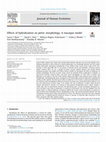
Journal of Human Evolution, 2021
Ancient DNA analyses have shown that interbreeding between hominin taxa occurred multiple times. ... more Ancient DNA analyses have shown that interbreeding between hominin taxa occurred multiple times. Although admixture is often reflected in skeletal phenotype, the relationship between the two remains poorly understood, hampering interpretation of the hominin fossil record. Direct study of this relationship is often impossible due to the paucity of hominin fossils and difficulties retrieving ancient genetic material. Here, we use a sample of known ancestry hybrids between two closely related nonhuman primate taxa (Indian and Chinese Macaca mulatta) to investigate the effect of admixture on skeletal morphology. We focus on pelvic shape, which has potential fitness implications in hybrids, as mismatches between maternal pelvic and fetal cranial morphology are often fatal to mother and offspring. As the pelvis is also one of the skeletal regions that differs most between Homo sapiens and Neanderthals, investigating the pelvic consequences of interbreeding could be informative regarding the viability of their hybrids. We find that the effect of admixture in M. mulatta is small and proportional to the relatively small morphological difference between the parent taxa. Sexual dimorphism appears to be the main determinant of pelvic shape in M. mulatta. The lack of difference in pelvic shape between Chinese and Indian M. mulatta is in contrast to that between Neanderthals and H. sapiens, despite a similar split time (in generations) between the hybridizing pairs. Greater phenotypic divergence between hominins may relate to adaptations to disparate environments but may also highlight how the unique degree of cultural buffering in hominins allowed for greater neutral divergence. In contrast to some previous work identifying extreme morphologies in firstand second-generation hybrids, here the relationship between pelvic shape and admixture is linear. This linearity may be because most sampled animals have a multigenerational admixture history or because of relatively high constraints on the pelvis compared with other skeletal regions.
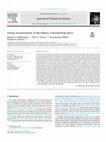
Journal of Human Evolution, 2021
The paucity of well-preserved pelvises in the hominin fossil record has hindered robust analyses ... more The paucity of well-preserved pelvises in the hominin fossil record has hindered robust analyses of shifts in critical biological processes throughout human evolution. The Kebara 2 pelvis remains one of the best preserved hominin pelvises, providing a rare opportunity to assess Neanderthal pelvic morphology and function. Here, we present two new reconstructions of the Kebara 2 pelvis created from CT scans of the right hip bone and sacrum. For both reconstructions, we proceeded as follows. First, we virtually reconstructed the right hip bone and the sacrum by repositioning the fragments of the hip bone and sacrum. Then, we created a mirrored copy of the right hip bone to act as the left hip bone. Next, we 3D printed the three bones and physically articulated them. Finally, we used fiducial points collected from the physically articulated models to articulate the hip bones and sacrum in virtual space. Our objectives were to (1) reposition misaligned fragments, particularly the ischiopubic ramus; (2) create a 3D model of a complete pelvis; and (3) assess interobserver reconstruction variation. These new reconstructions show that, in comparison with previous measurements, Kebara 2 possessed a higher shape index (maximum anteroposterior length/maximum mediolateral width) for the pelvic inlet and perhaps the outlet and a more anteriorly positioned sacral promontory and pubic symphysis relative to the acetabula. The latter differences result in a lower ratio between the distances anterior and posterior to the anterior margins of the acetabula. Generally, the new reconstructions tend to accentuate features of the Kebara 2 pelvis eethe long superior pubic ramus and anteriorly positioned pelvic inleteethat have already been discussed for Kebara 2 and other Neanderthals.
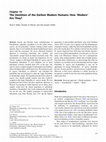
African and Western Asian contemporaries of Neanderthals, generally considered to be the earliest... more African and Western Asian contemporaries of Neanderthals, generally considered to be the earliest Homo sapiens, are not particularly ‘modern’ looking in their cranial anatomy. Here we test whether the dental morphological signal agrees with this assessment. We used a Bayesian statistical approach to classifying individuals into ‘modern’ and ‘non-modern’ groups based on dental non-metric traits. The classification was based on dental trait frequencies for two ‘known’ samples of 109 Upper Paleolithic H. sapiens and 129 Neanderthal individuals. A cross-validation test of these individuals correctly classified them 95% of the time. Our early H. sapiens sample included 41 individuals from Southern Africa, Northern Africa and Western Asia. We treated our early H. sapiens individuals as ‘unknown’ and calculated the probability that each belonged to either the Upper Paleolithic or Neanderthal sample. We hypothesized that if the earliest H. sapiens were already dentally modern, then they would be assigned to the Upper Paleolithic H. sapiens group. We also hypothesized that if there had been significant admixture in Western Asia during the initial dispersal out of Africa, these samples would have the largest proportion of individuals classified as Neanderthal. Our results indicated that the latter was not the case. The smallest proportion of misclassified individuals came from Western Asia (7%) and the highest proportion of misclassified individuals came from Northern Africa (38%). In most cases it appears to be the predominance of primitive features, rather than derived Neanderthal traits that drove the classification. We conclude (1) by the time the earliest H. sapiens dispersed from Africa they had already attained a more-or-less modern dental pattern; (2) in the past, as is the case today, Late Pleistocene Africans were not a homogeneous group, some retained primitive dental traits in higher propor- tions than others. Furthermore, we acknowledge that while our method is an excellent tool for discriminating between Upper Paleolithic H. sapiens and Neanderthals, it may not be appropriate for testing Neanderthal – H. sapiens admixture because all traits (primitive and derived) are weighed equally. Moreover, to best assess admixture it is likely necessary to incorporate a model for how the traits track population history and/or gene flow.
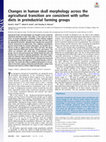
Agricultural foods and technologies are thought to have eased the mechanical demands of diet—how ... more Agricultural foods and technologies are thought to have eased the mechanical demands of diet—how often or how hard one had to chew—in human populations worldwide. Some evidence suggests correspondingly worldwide changes in skull shape and form across the agricultural transition, although these changes have proved dif- ficult to characterize at a global scale. Here, adapting a quantitative genetics mixed model for complex phenotypes, we quantify the in- fluence of diet on global human skull shape and form. We detect modest directional differences between foragers and farmers. The effects are consistent with softer diets in preindustrial farming groups and are most pronounced and reliably directional when the farming class is limited to dairying populations. Diet effect magni- tudes are relatively small, affirming the primary role of neutral evo- lutionary processes—genetic drift, mutation, and gene flow structured by population history and migrations—in shaping diversity in the hu- man skull. The results also bring an additional perspective to the par- adox of why Homo sapiens, particularly agriculturalists, appear to be relatively well suited to efficient (high-leverage) chewing.
Comparisons of QST to FST can provide insights into the evolutionary processes that lead to diffe... more Comparisons of QST to FST can provide insights into the evolutionary processes that lead to differentiation, or lack thereof, among the phenotypes of different groups (e.g., populations, species), and these comparisons have been performed on a variety of taxa, including humans. Here, I show that for neutrally evolving (i.e., by genetic drift, mutation, and gene flow alone) quantitative characters, the two commonly used QST estimators have somewhat different interpretations in terms of coalescence times, particularly when the number of groups that have been sampled is small. A similar situ- ation occurs for FST estimators. Consequently, when observations come from only a small number of groups, which is not an unusual situation, it is important to match estimators appropriately when comparing QST to FST.
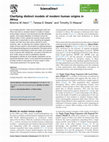
Accumulating genomic, fossil and archaeological data from Africa have led to a renewed interest i... more Accumulating genomic, fossil and archaeological data from Africa have led to a renewed interest in models of modern human origins. However, such discussions are often discipline- specific, with limited integration of evidence across the different fields. Further, geneticists typically require explicit specification of parameters to test competing demographic models, but these have been poorly outlined for some scenarios. Here, we describe four possible models for the origins of Homo sapiens in Africa based on published literature from paleoanthropology and human genetics. We briefly outline expectations for data patterns under each model, with a special focus on genetic data. Additionally, we present schematics for each model, doing our best to qualitatively describe demographic histories for which genetic parameters can be specifically attached. Finally, it is our hope that this perspective provides context for discussions of human origins in other manuscripts presented in this special issue.
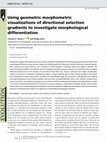
Researchers studying extant and extinct taxa are often interested in identifying the evolutionary... more Researchers studying extant and extinct taxa are often interested in identifying the evolutionary processes that have lead to the morphological differences among the taxa. Ideally, one could distinguish the influences of neutral evolutionary processes (genetic drift, mutation) from natural selection, and in situations for which selection is implicated, identify the targets of selection. The directional selection gradient is an effective tool for investigating evolutionary process, because it can relate form (size and shape) differences between taxa to the variation and covariation found within taxa. However, although most modern morphometric analyses use the tools of geometric morphometrics (GM) to analyze landmark data, to date, selection gradients have mainly been calculated from linear measurements. To address this methodological gap, here we present a GM approach for visualizing and comparing between-taxon selection gradients with each other, associated difference vectors, and “selection” gradients from neutral simulations. To exemplify our approach, we use a dataset of 347 three-dimensional landmarks and semilandmarks recorded on the crania of 260 primate specimens (112 humans, 67 common chimpanzees, 36 bonobos, 45 gorillas). Results on this example dataset show how incorporating geometric information can provide important insights into the evolution of the human braincase, and serve to demonstrate the utility of our approach for understanding morphological evolution.
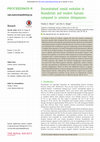
A variety of lines of evidence support the idea that neutral evolutionary processes (genetic drif... more A variety of lines of evidence support the idea that neutral evolutionary processes (genetic drift, mutation) have been important in generating cranial differences between Neandertals and modern humans. But how do Neandertals and modern humans compare with other species? And how do these comparisons illuminate the evolutionary processes underlying cranial diversification? To address these questions, we used 27 standard cranial measurements collected on 2524 recent modern humans, 20 Neandertals and 237 common chimpanzees to estimate split times between Neandertals and modern humans, and between Pan troglodytes verus and two other subspecies of common chimpanzee. Consistent with a neutral divergence, the Neandertal versus modern human split-time estimates based on cranial measurements are similar to those based on DNA sequences. By contrast, the common chimpanzee cranial estimates are much lower than DNA-sequence estimates. Apparently, cranial evolution has been unconstrained in Neandertals and modern humans compared with common chimpanzees. Based on these and additional analyses, it appears that cranial differentiation in common chimpanzees has been restricted by stabilizing natural selection. Alternatively, this restriction could be due to genetic and/or developmental constraints on the amount of within-group variance (relative to effective population size) available for genetic drift to act on.
Neandertal and modern human adults differ in skeletal features of the cranium and postcranium, an... more Neandertal and modern human adults differ in skeletal features of the cranium and postcranium, and it is clear that many of the cranial differences—although not all of them—are already present at the time of birth. We know less, however, about the developmental origins of the postcranial differences. Here, we address this deficiency with morphometric analyses of the postcrania of the two most complete Neandertal neonates—Mezmaiskaya 1 (from Russia) and Le Moustier 2 (from France)—and a recent human sample. We find that neonatal Neandertals already appear to possess the wide body, long pubis, and robust long bones of adult Neandertals. Taken together, current evidence indicates that skeletal differences between Neandertals and modern humans are largely established by the time of birth. body proportions | climatic adaptation | Homo neanderthalensis | infracranial | ontogeny
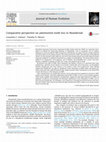
Neandertal specimens with severe antemortem (before death) tooth loss (AMTL) are sometimes interp... more Neandertal specimens with severe antemortem (before death) tooth loss (AMTL) are sometimes interpreted as evidence for human-like behaviors in Neandertals, such as conspecific care or cooking, although it is uncertain whether AMTL frequencies in Neandertals are similar to those in modern humans and exceed those in non-human primates. This study characterizes AMTL (all tooth types) in Neandertals relative to recent human hunter-gatherers and several non-human primate taxa using binomial-normal regression models fit in a Bayesian framework to a sample of 25 Neandertals, 310 recent human hunter-gatherers, 61 chimpanzees, 38 orangutans, and 75 baboons. The probability that a tooth is lost ante-mortem is modeled to depend on tooth class, taxon, and estimated age at death. Neandertals have odds of AMTL above orangutans and baboons, similar to or somewhat lower than chimpanzees, and below recent humans, if we assume a human-like rate of senescence; or intermediate between chimpanzees and recent humans, if we assume a faster rate of senescence. These findings suggest that Neandertals can only be considered to have frequencies of AMTL above non-human primates if they had more rapid life histories than modern humans. Either Neandertals are not human-like in their life history or their frequency of AMTL. These interpretations are complicated, however, by the substantial inter-population variation in AMTL among recent humans, with some populations having odds of AMTL as low as in non-human primates. These results, together with theoretical considerations, suggest that only high frequencies of AMTL are diagnostic of behavior. Consequently, the behavioral implications of low frequencies of AMTL, such as those found in Neandertals, are ambiguous. Low frequencies in Neandertals could be because they had a low risk of AMTL rather than because they had high mortality from AMTL relative to an average modern human of similar age.
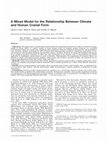
Objectives: We expand upon a multivariate mixed model from quantitative genetics in order to esti... more Objectives: We expand upon a multivariate mixed model from quantitative genetics in order to estimate the magnitude of climate effects in a global sample of recent human crania. In humans, genetic distances are correlated with distances based on cranial form, suggesting that population structure influences both genetic and quantitative trait variation. Studies controlling for this structure have demonstrated significant underlying associations of cra-nial distances with ecological distances derived from climate variables. However, to assess the biological importance of an ecological predictor, estimates of effect size and uncertainty in the original units of measurement are clearly preferable to significance claims based on units of distance. Unfortunately, the magnitudes of ecological effects are difficult to obtain with distance-based methods, while models that produce estimates of effect size generally do not scale to high-dimensional data like cranial shape and form. Methods: Using recent innovations that extend quantitative genetics mixed models to highly multivariate observations , we estimate morphological effects associated with a climate predictor for a subset of the Howells craniomet-ric dataset. Results: Several measurements, particularly those associated with cranial vault breadth, show a substantial linear association with climate, and the multivariate model incorporating a climate predictor is preferred in model comparison. Conclusions: Previous studies demonstrated the existence of a relationship between climate and cranial form. The mixed model quantifies this relationship concretely. Evolutionary questions that require population structure and phylogeny to be disentangled from potential drivers of selection may be particularly well addressed by mixed models. Am J Phys Anthropol 000:000–000, 2015. V C 2015 Wiley Periodicals, Inc.
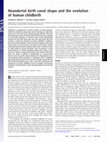
Proceedings of the National …, Jan 1, 2009
Childbirth is complicated in humans relative to other primates. Unlike the situation in great ape... more Childbirth is complicated in humans relative to other primates. Unlike the situation in great apes, human neonates are about the same size as the birth canal, making passage difficult. The birth mechanism (the series of rotations that the neonate must undergo to successfully negotiate its mother's birth canal) distinguishes humans not only from great apes, but also from lesser apes and monkeys. Tracing the evolution of human childbirth is difficult, because the pelvic skeleton, which forms the margins of the birth canal, tends to survive poorly in the fossil record. Only 3 female individuals preserve fairly complete birth canals, and they all date to earlier phases of human evolution. Here we present a virtual reconstruction of a female Neandertal pelvis from Tabun, Israel. The size of Tabun's reconstructed birth canal indicates that childbirth was about as difficult in Neandertals as in present-day humans, but the canal's shape indicates that Neandertals had a more primitive birth mechanism. A significant shift in childbirth apparently occurred quite late in human evolution, during the last few hundred thousand years. Such a late shift underscores the uniqueness of human childbirth and the divergent evolutionary trajectories of Neandertals and the lineage leading to present-day humans.
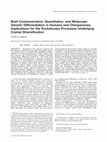
Estimates of the amount of genetic differentiation in humans among major geographic regions (e.g.... more Estimates of the amount of genetic differentiation in humans among major geographic regions (e.g., Eastern Asia vs. Europe) from quantitative-genetic analyses of cranial measurements closely match those from classical-and molecular-genetic markers. Typically, among-region differences account for 10% of the total variation. This correspondence is generally interpreted as evidence for the importance of neutral evolutionary processes (e.g., genetic drift) in generating among-region differences in human cranial form, but it was initially surprising because human cranial diversity was frequently assumed to show a strong signature of natural selection. Is the human degree of similarity of cranial and DNA-sequence estimates of among-region genetic differentiation unusual? How do comparisons with other taxa illuminate the evolutionary processes underlying cranial diversification? Chimpanzees provide a useful
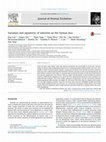
There has been much debate about why humans throughout the world differ in facial form. Previous ... more There has been much debate about why humans throughout the world differ in facial form. Previous studies of human skull morphology found levels of among-population differentiation that were comparable to those of neutral genetic markers, suggesting that genetic drift (neutral processes) played an important role in influencing facial differentiation. However, variation in soft-tissue morphology has not been studied in detail. In this study, we analyzed high-resolution 3D images of soft-tissue facial form in four Eurasian populations: Han Chinese, Tibetans, Uyghur and Europeans. A novel method was used to establish a high-density alignment across all of the faces, allowing facial diversity to be examined at an unprecedented resolution. These data exhibit signatures of population structure and history. However, among-population differentiation was higher for soft-tissue facial form than for genome-wide genetic loci, and high-resolution analyses reveal that the nose, brow area and cheekbones exhibit particularly strong signals of differentiation (Q st estimates: 0.3e0.8) between Europeans and Han Chinese. Our results suggest that local adaptation and/or sexual selection have been important in shaping human soft-tissue facial morphology.
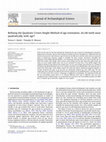
Teeth are the basis for the best methods for estimating the age-at-death of archaeological and pa... more Teeth are the basis for the best methods for estimating the age-at-death of archaeological and paleontological faunal remains, because they change by eruption and wear throughout an individual's life and because they preserve well. However, age-at-death can be difficult to estimate when teeth are isolated or when no known-age reference sample is available. For these reasons, researchers developed the Quadratic Crown Height Method (QCHM), a set of quadratic formulae that can be used to predict age-atdeath from tooth crown height, when unworn crown height and the ages when the tooth erupts and when its crown height should reach zero can be estimated. Previous tests of the QCHM suggest that modified equations could improve the method. Here, we use crown height measurements on a sample of 226 known-age Rocky Mountain elk (Cervus elaphus) to perform such modifications. We adjust the age at which each tooth type's crown height reaches zero from the species' potential ecological longevity or average maximum life span to an age that we empirically estimate for each tooth type. We also empirically assess whether for different elk teeth the exponent in the QCHM formula is actually equal to 2; it is for M1, but for P4 it is about 1, indicating a roughly linear relationship. The exponents for M2 and M3 are intermediate, being closer to 1.5. Because different teeth wear at different rates and wear completely away at different ages, we recommend that researchers use the modified equations provided here to estimate age-at-death for samples of Cervus elaphus.
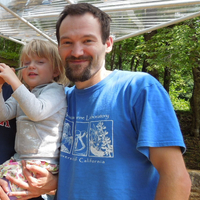




Uploads
Papers by Timothy D Weaver